This is my final “long-term” review of the Sette Razzo SC XX 29er mountain bike.
You can also read the first two parts of the review- Part One- Initial Impressions and Part Two- the First 100 Miles.
As of this writing (November 2012), I’ve had the bike for about 8 months. So far I’ve logged over 2,000 miles and nearly 300,000 vertical feet of climbing on the Razzo. I’ve ridden it extensively in the coastal mountains of Northern California, Lake Tahoe, Mendocino, and Central Oregon. I even raced it in the Marathon XC National Championships (54 mile MTB race as a Cat 1 Master). In summary, I’ve ridden the snot out of it in all different types of terrain- from buttery smooth, to rocky, technical dualie territory.
Normally, I wouldn’t consider 2,000 miles a “long-term” test of a bike. I typically ride my bikes into the ground for a few years. In the world of bike reviews, 2,000+ miles is definitely at the upper end of the spectrum. I’ve seen extensive reviews written for bikes with little more than a hot lap around the parking lot, so take it with a handful of salt.
Summary
 The bike rips! It is a light, capable, singletrack loving machine. The handling is very neutral, and it excels in tight, twisty singletrack.
The bike rips! It is a light, capable, singletrack loving machine. The handling is very neutral, and it excels in tight, twisty singletrack.
Despite my initial nervousness about buying an “off-brand” bike, I’m totally happy with the Sette Razzo. I have no complaints about the frame, or its longevity. After a couple thousand miles, I’m convinced it’s on par with any of the big names. The frame has taken the “normal” impacts of riding (e.g. pebbles flying off the front wheel and hitting the down tube, squeezing through tight trees and brush, etc.) without showing any significant wear, or any chipping of the clearcoat. The 5-year warranty is reassuring as well. I’d definitely buy another Sette carbon bike.
After my experience with the Razzo SC, I’ve looked at the Sette Dura Ace road bike and cyclocross bikes as well. If Sette releases a ‘cross disc bike in 2013, I’m there. I’d also strongly consider a Sette 29er dual suspension bike (if they make one in the future).
Notes on the 29er Hardtail
29ers have revitalized the hardtail market. After riding a dual suspension bike for years, I swore that I would never go back to a hardtail. When I was demoing dualie 29ers to pick out my next bike, I tried a 29er hardtail and was totally surprised that the hardtail 29er was the bike I had the most fun on.
I’d forgotten how light and nimble hardtail bikes feel. Even with a well designed dual suspension bike, there is always energy lost into the suspension. On a hardtail, you have snappy acceleration and all of your power goes into the drivetrain. The larger 29″ wheels do a good job of rolling over obstacles and minimizing chatter. The larger contact patch of the 29″ tire means better traction as well. Couple this with a good set of tubeless tires, and the 29er hardtail rides like it has a few inches of travel. On the down side, riding a plush dual suspension bike is like riding a couch- a couch that rips! Depending on your local trail conditions, you’ll definitely notice more vibration on a hardtail. There are trade offs for everything…
There are areas where the hardtail just isn’t as fast or comfy to ride as a dual suspension bike. If blasting down rutted fire roads, or hucking off big jumps is your thing, then a dual suspension bike is probably best. If you are more of a cross country type rider and like snappy acceleration and light weight, the 29er hardtail is worth a try.
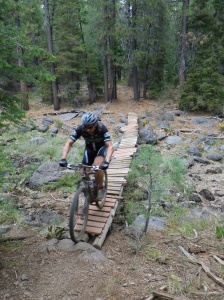 Riding a hardtail definitely requires more skill in picking a line. In really rocky terrain, I have to flow around obstacles that I can just blast through on a dualie. The 29er excels in technical rocky terrain. The big wheels roll over obstacles that my 26″ wheel can get hung up on. I’ve sometimes been frustrated when swapping back to the 26″ bike finding myself getting hung up on rocks I rolled right over on the 29er. Also, if you’ve been riding a dual suspension bike for a few years, you’ll immediately notice fewer pedal strikes (from the bottom bracket height floating on dualies).
Riding a hardtail definitely requires more skill in picking a line. In really rocky terrain, I have to flow around obstacles that I can just blast through on a dualie. The 29er excels in technical rocky terrain. The big wheels roll over obstacles that my 26″ wheel can get hung up on. I’ve sometimes been frustrated when swapping back to the 26″ bike finding myself getting hung up on rocks I rolled right over on the 29er. Also, if you’ve been riding a dual suspension bike for a few years, you’ll immediately notice fewer pedal strikes (from the bottom bracket height floating on dualies).
Depending on the terrain I’m riding, I regularly switch back and forth between my 26″ dualie and the Razzo SC. Now that I’m used to the neutral handling of the 29″ wheels, riding a 26er feels like a twitchy kids bike (still fun though). The 26er will only be around till I’ve saved a whole lot of pennies for a 29″ dualie.
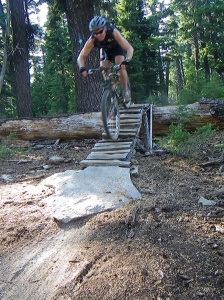 I’ve repeatedly heard the same two complaints about 29ers (from my friends who don’t ride them). First, that 29ers don’t handle well in tight, technical singletrack. Wrong. The Razzo SC has a shorter wheelbase than my dualie. I can ride tight switchbacks that I’ve never been able to ride on my dual suspension bike. The second complaint is that 29ers have sluggish acceleration due to the big wheels. Again, Wrong. I don’t notice any sluggish handling at all. Further, the 29ers roll over obstacles so well that they can maintain their speed. Bike designers have really dialed the 29er geometry. Don’t listen to the hype; some people will always be afraid of new technology. Go demo one on a real ride and see for yourself if a 29er fits your riding style. Parking lot demos are a waste of your time for anything but sizing.
I’ve repeatedly heard the same two complaints about 29ers (from my friends who don’t ride them). First, that 29ers don’t handle well in tight, technical singletrack. Wrong. The Razzo SC has a shorter wheelbase than my dualie. I can ride tight switchbacks that I’ve never been able to ride on my dual suspension bike. The second complaint is that 29ers have sluggish acceleration due to the big wheels. Again, Wrong. I don’t notice any sluggish handling at all. Further, the 29ers roll over obstacles so well that they can maintain their speed. Bike designers have really dialed the 29er geometry. Don’t listen to the hype; some people will always be afraid of new technology. Go demo one on a real ride and see for yourself if a 29er fits your riding style. Parking lot demos are a waste of your time for anything but sizing.
Growing up in the shadow of Mt. Tamalpais in Marin County, CA (the so-called birthplace of mountain biking), I’ve been riding bikes on dirt most of my life. I’ll paraphrase a friend who is a mountain bike pioneer, framebuilder, and in the Mountain Bike Hall of Fame. He says:
“We knew we were using the wrong size wheels when we started building mountain bikes in the 70s. At the time, the only fat tires we could get that had knobbies were 26″ BMX kids bike tires.”
So, the 26-inch standard for mountain bikes was an accident of history. 650B and 700C (29″ and 700C are the same) size wheels have been around for decades. Tire companies weren’t going to make a special production run of 700C knobby balloon tires for a bunch of hippy Marin bike weirdos in the ’70s. By the time mountain biking took off, the 26″ wheel had become the standard. There just weren’t any fat knobby tires for big wheels in the early years of mountain biking, and that’s why the 26″ BMX wheel became the de facto standard. Don’t get me wrong, I had a great time riding 26″ mountain bikes for over twenty years. I’m probably never going back to the 26″ wheel though- technology marches forward.
Bike Handling
Except in sizing, I really don’t care about the minutia of frame details. You won’t hear me talk about head angles or fork rake. Bike geeks (like me) often get caught up in the details of talking about bikes rather than just going out and riding them. What matters to me is that the bike rides well and handles tight singletrack. If it can’t clear tight switchbacks, I’m not interested.
The Razzo SC loves singletrack. Everyone loves singletrack! The Razzo SC is great in tight, twisty singletrack. If climbs and descends well, and is light enough to flick and make bunny hop corrections around corners.
The only weakness in handling of the Razzo SC is a general one. In long descents of rocky, rutted fire roads, a dual suspension bike would be faster. I’ve ruined a couple of rear tires trying to keep up with my friends on dual suspension bikes on rocky fire road descents. A rear suspension would have absorbed impact to the rear tire (and not flatted). Otherwise the Razzo SC does great. You can still ride really fast.
The Razzo SC climbs and descends very well. I’ve noticed no front wheel lifting on steep climbs, and no instability on descents. Due to their larger ground contact patch, 29er tires have great traction.
Keep in mind that the Razzo SC is a lightweight XC oriented bike. At 22+/- pounds with pedals, the Razzo is not a bike to be hucked on the jump track. I’m sure it’s up to the task, but you’ll probably likely be replacing wheels, and other carbon parts regularly. That said, who can resist catching air now and then.
What worked and what didn’t
I mentioned in parts 1 and 2 of the Sette Razzo review that Sette specifically put several components on their flagship XX bike to make the bike come in under 21 pounds. Some of these choices were fine… others not so much. As a consumer, we get caught up in “how much does it weigh?” I certainly was lured by the sub-21 pound weight of the bike. Most of the bike has a great spec. There are a few things that didn’t work out so well.
Stan’s tires– The Stan’s “The Crow” tires that came on the bike would probably be great for racing your MTB on the local ‘cross circuit. They are really light, semi-slick, minimalist tires. They are also ridiculous for real world riding (I couldn’t imagine these on a slick, rooty trail). They are still sitting in my garage, unused. The only use they’d see is for a race tire on a non-technical course. Although they helped the Razzo XX come in under 21 pounds, Sette should just spec better all around tires (especially on a $4400 bike).
Fizik saddle- Well, the saddle is really light and looks cool. After a few months, the foam compressed and I had to raise the saddle. After about 5 months, one of the carbon rails failed and broke. This would be a decent saddle for a road bike. I’m not convinced it’s appropriate for a mountain bike.
KMC chain- Again it’s flashy and is one of the lightest chains on the market. Broke after 2 months without warning on a flat trail (not high torque, missed shift, or out of the saddle climbing). I replaced it with a cheaper, slightly heavier SRAM chain and haven’t had any issues since. The KMC chain also created some extra drivetrain noise that went away immediately with a SRAM chain. Not worth saving 30 grams for an unreliable chain. You may have a different experience.
Chainstay protector- The chainslap on carbon when descending rocky trails is really loud. This bike needs a chainstay protector. I rode without one for a couple months. The bike is much more fun to ride when it’s stealthy and quiet.
Fox Float 29 fork- Great fork. Really easy to set up. Love the 15QR thru-axle (why did it take 20 years to think of it?).
Easton EA90 wheels- Light, and durable so far. I really prefer double walled rims that aren’t drilled out. This makes for a stronger wheel and not messing around with tape for tubeless tires. I did break one spoke on the rear. The spoke was bent so I think I hooked a branch with it. The wheels stayed so true that I didn’t notice the broken spoke for more than 20 miles. I’ve put on several hundred more miles since the broken spoke and it’s still perfectly true.
Internal cable routing- This is my first bike with all internal routing. I was a bit skeptical at first; now I think it’s great. Internal routing keeps the bike looking uncluttered, keeps cables out of the mud, and makes the bike easier to wash. Internal routing will be on my checklist for new mountain bikes.
Mystery creaking- This deserves it’s own section. I had frustrating creaking issues that I finally solved. Read more below.
Notes on SRAM XX
 I’m generally happy with the SRAM XX. It’s a bit like driving a Porsche- Light, high performance, race oriented. Like a Porsche, it can also also finicky. To keep the weight down, SRAM/Rock Shox use a lot of plastic parts. I suspect that the SRAM XX group won’t last as long as other component groups (Shimano XT/XTR, or SRAM XO), but it is marketed as a lightweight race group. (I’m still using my original 1989 Shimano Deore DX rapidfire shifters- they don’t make them like they used to!). The shifting and braking are what you’d expect in high end race components.
I’m generally happy with the SRAM XX. It’s a bit like driving a Porsche- Light, high performance, race oriented. Like a Porsche, it can also also finicky. To keep the weight down, SRAM/Rock Shox use a lot of plastic parts. I suspect that the SRAM XX group won’t last as long as other component groups (Shimano XT/XTR, or SRAM XO), but it is marketed as a lightweight race group. (I’m still using my original 1989 Shimano Deore DX rapidfire shifters- they don’t make them like they used to!). The shifting and braking are what you’d expect in high end race components.
The 2×10 is great. It reduces the complexity of the drivetrain and has a cleaner chain line. I’m so happy with 2×10 that I don’t think I’ll ever have a 3×10 mountain bike again.
I use only organic brake pads. The metal pads are cheaper and last longer, but also can squeal in wet conditions. Nothing like announcing your presence from 200 yards away. On the down side, the organic pads wear out quickly. In dusty, gritty conditions, I’ve burned through a set of organic pads in about 200 miles. Put brake pads in your riding budget.
The only complaint I have with SRAM XX is the (stupid) design of the rear cassette. Only the three largest cogs have splines allowing the cassette to flex and creak. Read more below.
Creaking Carbon (and how I solved it)

You can see the etching in the Titanium sleeve at the end of the SRAM XX cassette (click for larger pic).
About 3 months after buying the bike, the Razzo developed a mystery pedal induced creaking that reverberated through the frame. I went through everything multiple times- bottom bracket, pedals, saddle rails, seatpost, headset, derailleur hanger, etc. The creaking was maddening and I began to suspect that the bottom bracket shell wasn’t epoxied in properly. After pulling and regreasing the bottom bracket three times, I found the source of the creaking- the SRAM XX cassette. The XX cassette was flexing on the freehub body in certain gears and reverberating through the bike frame. Loud creaking even when soft pedaling. It sounded like a bottom bracket shell or seatpost flex.

The SRAM XX cassette flexing wore the anodizing off the Easton EA90 Freewheel hub after only 3 months
At nearly $400 retail, the SRAM XX cassette is the lightest cassette on the market. It also has what I would consider to be a stupid design that only has a spline on the largest (easiest) cog. This allowed the cassette to flex slightly in certain gears, which in turn reverberated through the entire frame. Slathering the free hub body with lube minimized the creaking for a few days, but is not a good solution. I finally changed to a cheaper (heavier) cassette, and the the problem went away immediately. As far as I’m concerned, the XX cassette is for race-day only.

The whole SRAM XX cassette has only one spline, which allows flex and puts all the stress onto one part of the freehub body.
In summary, my creaking issues were’t with the Razzo frame, but with the SRAM XX cassette. Carbon fiber frames can transfer and amplify sounds much like a guitar. My creaking sounded like it was coming from the bottom bracket. I’ve had mystery creaking issues on my Specialized S-Works Tarmac as well (related to the proprietary Specialized crankset). This is not an isolated incident. There are a number of Web complaints about noisy XX cassettes.

The vastly cheaper SRAM cassette has splines across the whole cassette. No flex! The problem went away immediately.
.
.
How could the Razzo SC be better?
Everyone loves constructive criticism, right? I have just a few suggestions on how to make the Sette Razzo SC a better bike.
Ditch the goofy semi-slick uber light tires. I’m convinced that the Stan’s Crow tires were specifically put on to make the bike come in under 21 pounds. Spec it with solid all around tires. (The WTB Bronson 2.2 is my current favorite rear tire. I also like the Maxxis Ignitor on the rear. For front tires I like the Specialized Captain 2.2, Schwalbe Racing Ralph, or Panaracer Rampage).
Include a chainstay protector with the bike. The chainslap on carbon is really loud and annoying. The bike is sooo much quieter with a quality chainstay protector. Sette sells two inexpensive chainstay protectors. For a $$$, bike, including a chainstay protector is a good customer service move.
Thru-axle rear wheel. When putting on and taking off the rear wheel of the Razzo SC, there is some flex when clamping the quick release. (I’ve also seen it on $10K S-Works bikes too, so it’s not limited to the Razzo). Thru-axle rear wheels are now widely available and a beefy, threaded thru-axle quick release just makes sense for stiffening up lightweight carbon rear ends. The 15QR thru-axle is gaining momentum on forks. I predict that rear thru-axles will be the standard on high end MTBs in the next few years. The technology curve changes rapidly in mountain bikes. Sette got on board early with the internal cable routing and other details. Best to get on board early with the thru-axle.
The Last Word
Hope the review helps. I’ve tried to give a fair, thorough, and unbiased review. I’ve had a great time with the bike and think you can’t go wrong wrong with the Razzo SC. I’ve seen carbon frame on sale as low as $600 with a 5 year warranty.
Sette/Price Point did a good job with component spec in going with tried and true brand name components on the build. In terms of value versus longevity, I think the Sette Razzo XO (at $2900 and 23.4 pounds with “real” tires) is a bit better deal. The XO group seems to be a bit less finicky for a bit more weight, and may outlast the XX components.
I’d definitely buy another Sette carbon bike, and I expect to ride this one several thousand more miles.
See you on the trail…
- Riding the North Umpqua Trail
- North Umpqua Trail
- Waterfalls and slippery bridges!
- Slippery rooty goodness on the North Umpqua Trail
- Putting the Razzo SC through extensive product “testing”
- Product Testing
- The ubiquitous map check
- Sick! See you on the trail!
- Nearby wildland fires make for smoky skies and great sunsets
- Playing with the Razzo in Phil’s Trail network- Oregon
- Putting the Sette Razzo SC through extensive “product testing”
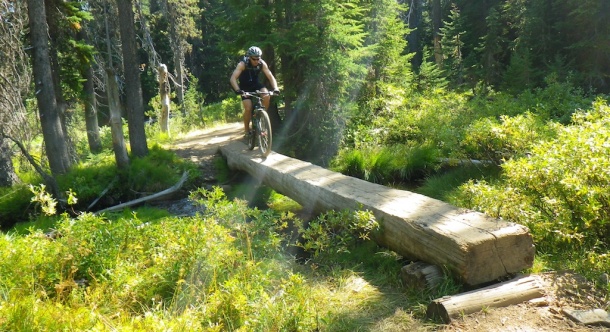


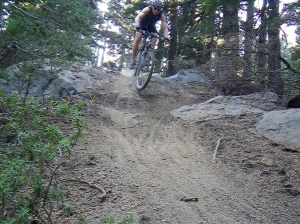
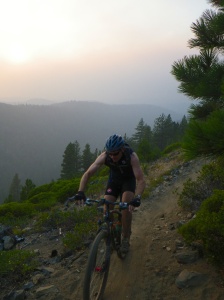
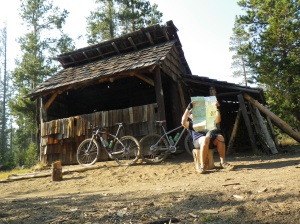

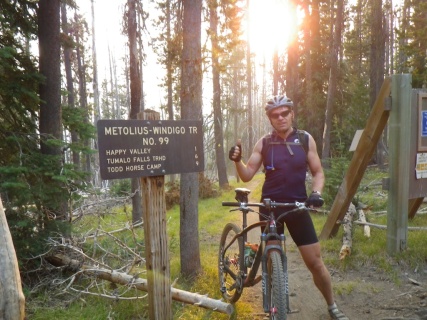


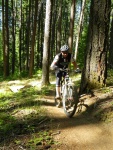
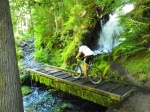





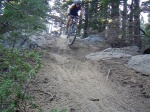
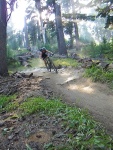
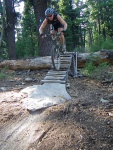
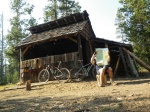

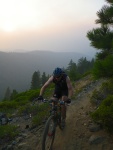




Awesome. I believe I know what Santa is bringing for Christmas. Oh, and if you ever find yourself in Costa Rica, shoot me an email.
LikeLike
AWESOME review. You could give a graduate class on how to write a bike review. Well done, and thank you.
I ordered the Rozzo SC X.O. equipped bike today based largely on your review and similar conclusions about parts, value, warranty, etc.
At 5’9″ I went ahead and ordered the Large (19″) size as I like a slightly stretched out geometry for XC racing. I ordered an Easton EC90 Carbon Zero Setback seatpost and a Truvativ Noir T30 600mm flat carbon bar that I’ll use with the included 90mm EA90 stem. That should get me to about 24lbs with pedals using the included wheels/tubes.
I wish the included Stans ZTR crest wheels had the Stan’s 3.30 hubs instead of the heavier Formula hubs, but they’ll make solid training wheels. Stan’s ZTR Race Gold wheels with sealant is all that’s needed before next year’s race season.
LikeLike
Thanks. Like most people these days, I go to the internet for research. Sites like MTBR are useful but the reviews often run along the lines of “I own this bike, so it rules!!!!” or “This one time I got a flat, this bike sucks.”
Couldn’t find much on the Razzo, so I wrote the type of review I’d want to read. Glad it was helpful.
LikeLike
Have you tried to bleed the rear brake yet with the cable inside the frame? That’s my only maintenance concern. Hopefully if you remove the lever from the bar so you can shake it around you can get the air out of the line.
LikeLike
I haven’t needed to bleed the brakes yet. I think it would be just fine with the giant syringe/capture reservoir method. Not sure who makes the tool, but it makes bleeding them a snap. uses a 30cc syringe at the brake and a clamp on capture reservoir at the lever. Flushes the whole system in a couple seconds and drives out any air. Also recaptures the leftover fluid.
LikeLike
Excellent write-up ! Thanks very much for taking the time to do that. I was wondering if you could give me a recommendation on which of the the following three models I found on the PricePoint web site you would recommend: SC X0 10 for $2,500; or SC X9 10 for $1,800; or SC X7 10 for $1,500?
I am 49 and am not a hard core MTB rider, and don’t do very technical rides nor any jumping. I like to do XC rides on trails and ride for exercise and getting-outdoors more than for thrills. I don’t want to overspend but don’t mind paying more where it’s worth it.
Thanks again.
LikeLike
Hey Todd- Thanks. I haven’t taken a close look at the X9 build, but I’d take a close look at the X0 or X9. I think the X9 is a triple chainring, and having a low granny ring may be to your liking. I’m a proponent of buying the appropriate level for your needs. For mountain/road bikes I buy Dura Ace/XTR/XX level components because I log thousands of miles on them. For our other bikes (town bikes/cargo bikes), I step way down. To some degree the X0/X9 components may last longer because they are not built to be like a Ferrari in terms of performance. You will pay a weight penalty, of course. Be sure to look at the fork and wheel spec too.
Good Luck.
LikeLike
I received my Razzo SC with X.O. the other day and took it for a ride today. My thoughts:
– I swapped out the heavy bars and seatpost for carbon versions. I went to a 600mm bar vs. the 685mm bar that was stock. When I put it back together, the brake cables were a little long but tolerable (as the brakes were now 85mm closer to each other). The shifter cables were way to close to I cut the housing down to a more manageable length.
– The tires, Kenda Slant 6’s, while not sealant compatible, rode really well with tubes. I’ll use a Maxxis Ignitor 2.1 in the rear and Maxxis Ikon 2.2 in the front with Stan’s sealant for races to drop a pound from the bike.
– The brakes were bled fine, but I had to adjust them to remove rotor rub. No big deal. The front derailleur clamp was a little loose, so I tightened up with a torque wrench.
– Weight: With the carbon bar, seatpost, two carbon cages, Time ATAC XS pedals and a Garmin 500, I came in at 23.1 pounds with the Slant 6 tires and tubes. I expect I’ll be at 22 pounds or a hair under with the Maxxis tires and sealant.
– The bike came with the 2013 Fox CTD 100 fork. I really wanted this for so I could use Fox’s remote lever instead of jury-rigging something like you have to do on the RLC version. Very happy with the fork.
Overall, a great buy and after bars/seatpost/tire upgrade I figure the whole bike cost me $2,800
LikeLike
Now, for the ride quality:
Like any 29er, you need to initiate your turn a little earlier and use slightly different body english than you do on a 26″ bike.
I found the Razzo to turn just OK when I used my hip to lean the bike into a turn (like I do on my 26″). When I used my inside hand to push down on the bar on a corner to initiate the turn, the bike dived into the turn and railed like a race bike should.
No flex in the bottom bracket, although I’m only 140 lbs at 5’9″. The fork is great. I rode pretty much the entire ride in the “trail” setting. The “climb” setting works well, and I’m looking forward to when my remote lever arrives.
When going over roots, larger rocks, etc, the shock soaked them up in trail mode but I never bottomed out.
No squeaks or creaking from the BB, seat post (after using torque past and a torque wrench at 5.5nm to tighten it up), or bars. The cable action through the internally routed cables is smooth.
The 2×10 cranks with 26/39 rings and a 11/36 cassette is a good combo. Plenty of granny gear. Maybe lacking a little on the high end as you could spin out the 39/11 on a fast downhill fire road or hard trail in a race, but that would be a rarity I would think.
Overall, I am SUPER happy with the bike so far. The warranty really gives you piece of mind as well, and it’s the same 5-year warranty that comes with a $2,200 Niner Air9 RDO frame.
LikeLike
nice blog you have here with great content and awesome photos.
LikeLike
Great review – thanks for putting so much time into it. Your findings on the source of the creaking are especially valuable – that’s the kind of thing you can chase for a long time and not identify.
LikeLike
Just curious to hear your thoughts about how you think this bike would preform as a bikepacking bike? I know everyone loves steel for these types of duties but LIGHT sounds good to me. Just concerned with carbon and the wear and tear from frame bags and bikepacking gear? Thanks for your review.
Todd
LikeLike
In a word- poorly.
The Razzo has no rack mounts, asymetric carbon tubes, and a wishbone rear seatstay. Getting panniers onto it would be clunky at best unless you used a seatpost rack along with a beefy seatpost. Then you need to worry about cantilevering weight on the seat tube. Personally (and I’ve done a few thousand miles of self supported touring with hundreds of miles of dirt), I’d go with a steel or aluminum 29er frame with full rack mounts and a low geared 3×10 drivetrain for spinning up long climbs with a load (2×10 isn’t really geared for loaded touring). Also, if you are a big guy I’d consider 26″ wheels (stronger wheel, less chance of failure in the middle of nowhere). I toured with with front and rear panniers on a 700c (29er) touring bike. I did hundreds of miles of dirt on 36-hole, 14G wheels, laced to tandem rims without ever having a broken spoke or wheel out of true.
Unless you are going for a 1-night fast and light overnight, you’ll want to make choices for reliability in the middle of nowhere.
Hope that helps.
P.S. I wrote up one of our bike tours on the blog, if you are interested. Salt Lake City to Albuquerque- 1,200 miles. We did almost 700 miles without seeing a stoplight. The blog post was awarded Freshly Pressed (a weekly selection of the best blog posts from the WordPress world).
LikeLike
I appreciate your kindly help…. I am in the process of buying a 29er, My options are ( in my preference order of buying…)
http://www.bikesdirect.com/products/motobecane/fantom_ti_29_x9_30.htm
http://www.bikesdirect.com/products/windsor/carbon29er_comp.htm
http://www.pricepoint.com/detail/24533-018_SETR12-277-Bikes–/Sette-Razzo-SC-X9-V2-10s-29er-Carbon-Bike—Gloss-Black-with-Crimson-Red.htm
Do you have any experience with Bikesdirect? .. What about titanium?
I really appreciate your comments.. to a unexperience bike rider… I am looking for a durability bike, that can be ride over most terrains.. not for compiting.. just for weekend ridding…
LikeLike
Glad I could be of help. For an inexperienced cyclist, I would strongly recommend going to a good bike shop and not buying online. A good shop will help you get properly fitted, change stem/bars/saddle as necessary, and help you with maintenance down the road. If you purchase a bike through bikes direct, you can expect no service, support, or warranty service should you need it. (I’ve worked as a bike mechanic and have the tools and knowledge to do 90% of my own maintenance and repair).
I don’t recommend buying from a “discount” online bike place unless you are experienced enough to know exactly what you need in terms of fit and can do your own maintenance. I’ve looked as bikesdirect.com and wouldn’t buy a bike from them. At least Pricepoint has been in business for a long time, has a physical business, and you can pick up the phone and call them. They have a good reputation…
So go, ride a bunch of bikes at a good bike shop. See what fits you best and go from there.
Also, a “good” titanium frame from a reputable builder can last forever. Having said that, carbon is light and strong (stronger than many aluminum, steel, and ti bikes). There are a zillion variables in frame building. You can build a weak titanium frame (one of the discount brands), or a rock solid carbon bike (tubing, carbon layup, the skill of the welder, etc. all factor into frame building). I’ve had 5-6 carbon bikes now and no problems.
Good luck
LikeLike
Thank you for replay… I mentioned unexperience compare to other guys that I sometimes ride with…. They are pro´s .. compare with me… I have a little knowledge about this.. and I have been learning.. about bike reparing … yesterday I just adjust my disk brakes becuase the tires weren´t rolling freely … :o) … I know that my recommended size is 21″, I am 6´3 guy… right now I have a 26 bike…
Reading you answer.. I realize you haven´t tried any bikesdirect´s product… and Also.. that maybe I have a wrong impression about carbon fiber frames… about their fragility … or not?
I am looking for this product..as you mention for the less cost .. becuase any other similar product.. will be more expensive…other that I have been considering is Scott scale 950.. but these other bikes that I mentioned have higher quality group .. that 950 … this is something it is very importat to me at least.. but maybe I shouldn´t make this issue as important as I am considering it.
I appreciate your kindly help.
regards
LikeLike
Enjoyed reading your informative series on the Razzo. Your opinions, that’s all a review is right, are presented within the context of your experience and knowledge making them credible and good prose at the same time. I’m signing up for a subscription for some enjoyable reading.
I’m certain you have more pressing issues, but might I bother you for your opinion on forks?
Not sure what fork was on your Razzo. The XO now runs the Float CTD. For the XC riding you do how critical is that CTD function? Would a REBA perform just fine. Thanks for your time and the enjoyable, informative read.
LikeLike
Hi there. Thanks for the kind words. Sorry for the late reply. Just realized I had dozens of comments backlogged. I haven’t ridden the CTD yet, but love the concept. I actually lock out my fork anytime I’m on pavement or climbing on dirt roads. Personally, I really like the simplicity of Fox fork setup. Really easy to dial in sag in a couple minutes. I’m not a fan of the positive/negative air chambers on some of the rock shox. (My really fast girlfriend has a Rock Shox XX world cup. She’s blown the chambers repeatedly, and they are constantly leaking air. Plus, Rock Shox uses a lot more plastic parts to keep the weight down).
So far I’m really happy with the Fox Fork. I’ve had several cannondale lefty, a few marzocchis, and others. Love the light weight and uber stiffness of the cannondale lefty, but have they always had maintenance issues.
LikeLike
hi tahoe sux! I have the following question: waht do you think abaut the sette derro 1.0 full suspension? I’m indécis between this and the razzo.
Regards
LikeLike
Hi there. Sorry for the late reply. I actually didn’t look at anything but hardtail 29ers. I’d taken a whole bunch of bikes out for real test rides (on technical trails), and was surprised that I liked the hardtails the best.
LikeLike
Great update!
The Razzo has been good for me and I’ve done the kind of riding you have for the last year – 11 months of XC racing, lots of riding of all kinds. Nice to see you enjoyed the great trails of the Bend area too (I also did the Mtb Marathon Nationals – more like “participated in the adventure”).
I’ve tried it with 650B wheels but really think that they don’t suit it that well – lose some rolling capability, more pedal strikes on tight, technical because of lower BB height.
The only occasional issue I’ve had is the rear wheel axle shifting causing tire to rub against the chainstay – I assume due to flex in the chainstay. You really need to really clamp the rear wheel quick release HARD.
I smile as I ride by folks who’ve spent a lot more for a “big name” brand bike.
LikeLike
Great review. I am thinking the XO model with some Hope hubs on Stan’s rims. The XX cassette and stuff is a bit expensive to replace and wears out quickly. Price Point does have the XX model for $3,200 with a 15% rebate.
LikeLike
Thanks- I actually think the XO model is a better deal. Same frame and fork. The XX stuff is great, but like driving a ferrari. Finicky and eXXpensive, but light and fast. I tore off a derailleur (branch) and could only get an XO derailleur in time for the next epic ride. Can’t tell the difference between it and the XX.
LikeLike
I just want to thank Sux again for his great review.
Based on it I bought the XO build and it has been great. Just did a 24 hr relay race and it performed beyond expectations. Only thing I’ve changed at this point was the grips for a little more give than the Sette it came with.
I haven’t experienced any chain slap yet. Figured that was because we have some smooth trails, but the 15 mi course this weekend had lots of cobbled rock gardens and still no significant chain slap. Great deal, great ride.
LikeLike
How’s the Sette sc doing???
Frame staying strong?
LikeLike
Hey Dale- Sorry for the late reply. Frame still going strong after more than 3,500 miles, mostly technical singletrack. I’ve even taken a couple unexpected hits to the frame without any problems. Got the usual nicks and scratches from brush/use etc. Definitely would buy another one. I would even just buy a replacement frame at $600 (or less) if I cracked it.
LikeLike
Excellent review. If you had to do it again would you have gone with the 21 inch frame?
LikeLike
Thanks- The 19″ frame is the right size for me. I got professionally fitted for all my bikes by wholeathlete.com. The only change I needed on the Sette was to go to a 100mm stem, and a few tweaks to saddle/cockpit position. Otherwise great bike… Keep an eye on PricePoint sales. They were selling gift certificates for 20% off not long ago and had a 1-day sale on the Razzo XX for $3,000. Time everything right and you could pick up an XX bike for about $2500.
LikeLike